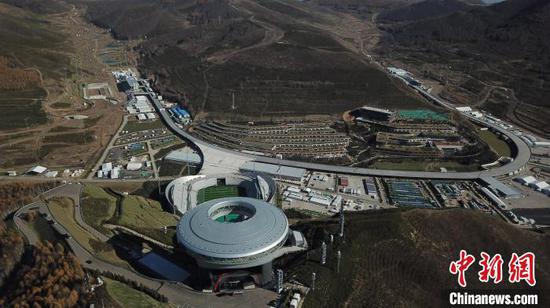
Aerial photo taken on Nov. 30, 2018 shows the "Yungui" driverless monorail transit system at the headquarters of China's new energy vehicle maker BYD in Shenzhen, south China's Guangdong Province. (Xinhua/Mao Siqian)
China, the world's biggest producer and consumer of energy, is rapidly reducing its energy consumption intensity, as higher energy efficiency will support the country's transition to a modern green economy.
China's energy intensity -- energy consumption per unit of GDP -- decreased 28.7 percent from 2011 to 2020, one of the fastest reductions in the world, according to a white paper released Wednesday documenting the country's progress in mitigating climate change.
From 2016 to 2020, on average, China fueled an annual expansion in its economy of 5.7 percent, but the growth of its energy consumption only stood at 2.8 percent per year. During that time, the amount of energy saved in the country accounted for about half of the total in the world.
Under the goals of peaking its carbon dioxide emissions before 2030 and achieving carbon neutrality before 2060, China is accelerating the transformation to a clean and low-carbon energy consumption structure.
LESS RELIANT ON COAL
China is becoming less reliant on coal, with the proportion of coal consumption declining significantly to address pollution and climate change caused by fossil-fuel combustion.
The country's energy consumption was kept under 5 billion tonnes of standard coal in 2020, and the proportion of coal consumption dropped from 72.4 percent in 2005 to 56.8 percent in 2020.
China has over-fulfilled its target for cutting coal output capacity, eliminating more than 45 million kW of outdated coal and electricity output capacity during the 2016-2020 period.
Non-fossil energy is developing rapidly, with China developing and utilizing alternative energy sources.
In 2020, non-fossil energy contributed 15.9 percent to China's total energy consumption, a significant rise of 8.5 percentage points compared with 2005. The installed capacity of non-fossil energy power generation in China reached 980 million kW, accounting for 44.7 percent of the total installed capacity. Electricity generated by non-fossil energy reached 2.6 trillion kWh, representing more than one-third of the power consumption of the country.
For example, Shanxi Province, one of China's major coal-producing regions, will see the installed capacity of new and clean energy reach half of its total, with one-third of its electricity generated by new and clean energy by 2025. By the end of 2020, the installed capacity of new and renewable energy power generation reached 35.7 million kW, accounting for 34.38 percent of the province's total.
From 2016 to 2020, China issued 16 mandatory energy consumption quota standards, achieving an annual energy saving of 77 million tonnes of standard coal, equivalent to 148 million tonnes of carbon dioxide emissions; it issued 26 mandatory product and equipment energy efficiency standards, realizing an annual power saving of 49 billion kWh.
In Yulin, a coal-rich city in northwest China's Shaanxi Province, a chemical plant has been exploring its own form of green transition.
"The coal chemical industry should boost its green transition and seek the high-end and differentiated development of its industrial chains to make eco-friendly products in line with the market demand," said Zhang Xiansong, chairman of CNH Energy Yulin Chemical Co., Ltd.
Through the efficient use of coal, the company managed to produce green end-products including daily necessities, absorbable medical sutures and bone stents, as well as degradable materials.
The local chemical company mirrors the wider efforts made by the country to encourage local governments, industries and enterprises to explore low-carbon paths to development based on their individual conditions.
GREEN PATH
China's green endeavors have spanned various sectors, including construction, transport and the manufacturing of new-energy vehicles, receiving support from the finance sector and the carbon market.
In the latest move, the authorities have issued a guideline underpinning green development in urban and rural areas, setting the goals of basically establishing institutional mechanisms and policy systems for green development in urban and rural areas by 2025, while green development will cover urban and rural areas in a comprehensive way by 2035.
In the transport sector, notable progress has also been made in building low-carbon urban transport systems. As of the end of 2020, 87 cities on China's mainland had joined the national program to improve public transport, and 43 cities had launched urban rail-transit networks. During the 2016-2020 period, the number of trips by urban public transport exceeded 427 billion, signifying a steady increase in the proportion of city dwellers using public transport.
China has outpaced many other nations in the production and sale of new-energy vehicles for six straight years. It has also topped the world in the output of some major products for photovoltaic power generation over the past eight years.
Dedicated government support on green finance and the carbon market will help boost energy efficiency, catalysing the clean-energy transition.
In the finance sector, China has increased green-finance support and improved the top-level design of green finance. It has set up nine pilot zones for the reform and innovation of green finance in six provincial-level administrative units.
The carbon market provides an effective approach to managing the relationship between economic development and the reduction of carbon emissions. The national carbon emissions trading market is a major institutional innovation that uses market mechanisms to control and reduce greenhouse gas emissions and promote green and low-carbon development.


















































 京公网安备 11010202009201号
京公网安备 11010202009201号